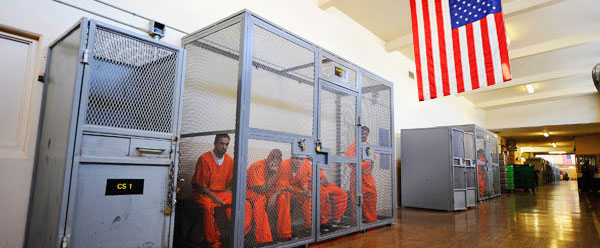After Philadelphia Prison Case, Many Still Weigh the Effects of Releasing Inmates

Inmates in cages in a hallway at Chino State Prison wait for housing assignments or for pending appointments. Photo by Kevork Djansezian/Getty Images.
Deputy Philadelphia District Attorney Sarah Vandenbraak Hart winced as a federal judge signed off on a settlement the city reached in a 1986 jail overcrowding case. The pact would force the city to release thousands of inmates and to turn others away at the cell door upon arrival.
“I remember the day the order was entered,” recalls Hart, who, 25 years later, still is fighting cases over jail conditions. “I turned to a colleague and said, ‘Somebody’s going to die over this.’ ”
It happened in 1991, when recently released car thief Edward Bracey gunned down 21-year-old rookie police officer Daniel Boyle. The officer had chased Bracey, who was driving a stolen car. Bracey, now on death row, fired eight times at Boyle, killing him.
U.S. Supreme Court Justice Samuel A. Alito Jr. may have had a similar premonition when, in 1995 as a judge on the 3rd U.S. Circuit Court of Appeals at Philadelphia, he partially dissented from an affirmation of a contempt finding against the city for failing to live up to its end of the consent decree. On the high court, Alito recounted the Philadelphia story last term as a dissenter in a California prison overcrowding decision that similarly could put thousands of felons back on the streets.
“The majority is gambling with the safety of the people of California,” Alito complained in Brown v. Plata, decided May 23. “I fear that today’s decision, like prior prisoner release orders, will lead to a grim roster of victims. I hope that I am wrong.”
The justices affirmed 5-4 a three-judge panel’s order to cap California’s prison population to cure ongoing Eighth Amendment violations caused by overcrowding. Justice Anthony M. Kennedy made the difference by joining the court’s four-member liberal faction.
OVERLOOKED FROM OVERCROWDING
The case began in 1990 on behalf of mentally ill inmates who received little or no treatment. Prisoners with physical ailments joined them with a second complaint in 2001, and the combined cases decided by the high court expanded to cover all the state’s 143,000 adult inmates, held in 33 facilities. The system is designed to hold only about 80,000 prisoners, and the courts have ordered officials to reduce the population to 137.5 percent of capacity by 2013. The panel acknowledged that population reduction alone won’t remedy all the Eighth Amendment violations.
Yet the Supreme Court majority still appeared torn between public safety and prison conditions.
“High recidivism rates must serve as a warning that mistaken or premature release of even one prisoner can cause injury and harm,” Kennedy wrote. “The release of prisoners in large numbers—assuming the state finds no other way to comply with the order—is a matter of undoubted, grave concern. … Yet so too is the continuing injury and harm resulting from these serious constitutional violations.”
Population cuts won out as Kennedy described two decades of deplorable conditions. Included was one instance where an inmate awaiting mental health services was found nearly catatonic and standing in a puddle of his own urine after spending 24 hours in a cage the size of a telephone booth. Prison officials explained they had no place to put him.
But though the federal statute governing the case requires courts to accord “substantial weight” to public safety when ordering population reductions, Kennedy bought into statistical expert evidence presented to the panel at trial that the state can accomplish that without threat to the public.
The three judges also concluded from the testimony that public safety actually could improve through accompanying programs and incentives aimed at rehabilitating prisoners in addition to merely releasing them with nothing more.
For example, the state now provides extensive time off sentences for eligible prisoners who take college courses or participate in other approved educational programs. And the state has stopped returning many parole violators to prison, so long as they have no prior convictions for serious or violent offenses, posed no disciplinary problems while locked up and are not gang members.
Neither the panel nor the Supreme Court, however, expressly ordered or endorsed releases, instead citing efforts California already has made in building new prisons and shipping some 10,000 inmates out of state.
When the three-judge panel first convened in 2006, the system was operating at more than double its capacity. As of early June this year, the state said it had reduced the inmate population by 19,000, putting it at slightly less than 180 percent of capacity.
A more ambitious plan to move some low-level offenders to county jails begins Oct. 1.
RECIDIVISM REPERCUSSIONS
U.S. District Judge Norma L. Shapiro also didn’t order wholesale releases in settling the Philadelphia case. But that’s exactly what authorities there say happened. And Philadelphia police kept track.
In an 18-month period from January 1993 through June 1994, police reported rearresting 9,732 prisoners released because of the cap. New charges included 79 murders, 1,113 assaults, 959 robberies, 701 burglaries, 90 rapes, 14 kidnappings, 264 firearms violations, 2,748 thefts, 2,215 drug-dealing offenses and 127 counts of drunken driving. Besides Boyle, five other police officers were shot but survived.
“The problem is that you’re dealing with an incredibly risky population, especially when you throw in mental health issues and drug addiction,” says prosecutor Hart. She co-authored an amicus brief in the California case for 18 states worried they someday may have to defend lawsuits like the one that hit California.
“Of course, it was neither the intention nor the expectation of the district court in Philadelphia that imposing a population cap on the local prison system would lead to such violence against police and other innocent victims,” the amicus brief acknowledges. “Judicial intervention into prison affairs invariably begins with the best of intentions.”
Critics and the Supreme Court majority simply don’t believe the Philadelphia experience. “That’s never been substantiated to my knowledge,” says lead California in mate lawyer Donald Specter, director of the Prison Law Office in San Quentin.
California officials first agreed to shrink the inmate count in 2009. They insist they can meet the plan’s goals without releasing any serious or violent felons, such as murderers and rapists. Those criminals still would be sentenced to state prison and not moved to county jails as California, under a process known as realignment, tries to shift the population and at least some of the responsibility away from itself. Sheriffs would be able to consider alternatives to incarceration, such as electronic monitoring of new arrivals from the state system.
Hart says she’ll believe in realignment when she sees it work. “What you often see, when you move people around,” she says, “is that it puts more pressure on the state to release.”
FUNDING REALIGNMENT
County jails began bracing for the influx of new residents against an uncertain legislative backdrop.
“It’s not a good time to be a sheriff in California,” says Curtis Hill, lobbyist for the California State Sheriffs’ Association.
“Still, we’re in support of that as long as we get full funding,” says Hill, who served as sheriff in San Benito County, just south of the San Francisco Bay Area, from 1999 to 2010.
Indeed, Republican legislators nearly killed realignment before it started, citing fear for public safety and opposition to new taxes to support it. Their stubbornness forced Democratic Gov. Jerry Brown to rely on a simple majority—all Democrats and not a single Republican—to re allocate a portion of the state sales tax to raise the $5.1 billion needed to kick it off.
But the legislature can’t raise new taxes permanently to pay for realignment without Republicans because that requires a two-thirds majority and voter approval. “With out those guarantees, it could be problematic,” Hill says.
More immediately, the realignment money won’t be available until Oct. 1, while the first 10,000 felons to be sent to counties must ship out by Dec. 27 under the three-judge panel’s order. It could be a close shave. Though the state can ask for an extension, it estimated in late July that it could clear out only 8,500 prisoners by then. “I don’t think they can make it,” says inmate lawyer Specter.
Also unanswered is just how far the state can go in handing inmates over to counties before local jails are crammed full.
With or without the money, though, for some the prospect of dangerous felons preying on the public remains very much real. “In a few years, we will see,” wrote Justice Alito.



